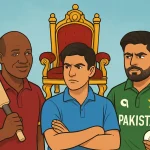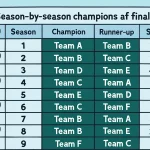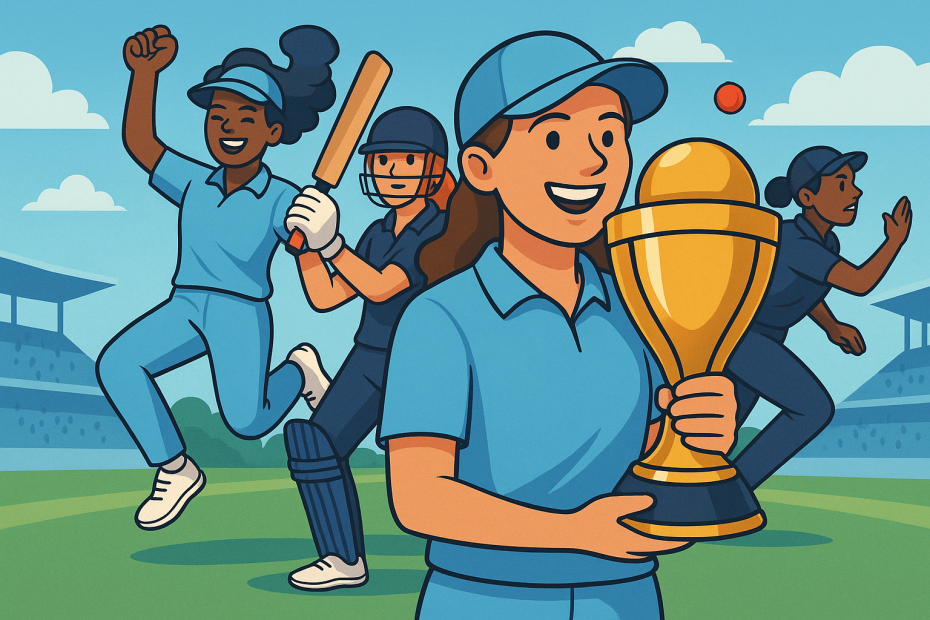Sometimes, revolutions begin quietly—far from roars of packed stadiums or the glare of global media. This is the story of one such revolution. An international cricket tournament played before the term “ODI” had truly seeped into the mainstream, let alone connected with women’s sport. A daring, exhilarating, and world-defying commencement: the first Women’s ODI World Cup, hosted in England.
Before the glitz of modern ICC Women’s World Cups, before hefty sponsorships, packed MCGs, and multi-million-viewer broadcasts, there was — a game stitched together by grit, borrowed kits, and sheer passion. What happened during that inaugural world tournament didn’t just shape the trajectory of women’s cricket — it rescued it from the margins and knotted it permanently into the global cricketing narrative.
Hitting the First Ball in History: Scene Setting the World’s First Women’s Cricket World Cup
It all unfolded not in some dreamy, distant fairy tale, but on actual grounds like Hove and Edgbaston. The first Women’s One Day International (ODI) World Cup — a concept barely whispered in cricketing circles at the time — became reality through the tenacity of a woman named Rachael Heyhoe Flint. Not only was she England’s captain, but she was also the tournament’s heartbeat, strategist, fundraiser, and spirit.
Backed by business tycoon and cricket philanthropist Jack Hayward, Flint spearheaded the unprecedented effort of organizing an international tournament dedicated entirely to women’s cricket — more than half a decade before men’s cricket would adopt the World Cup model.
The format was daring: seven teams played round-robin matches across various English venues, including several counties best known for hosting Championship matches. And here’s the plot twist — the tournament featured a team named ‘Young England’ and even an International XI composed of expats and cricketers from non-participating nations. This wasn’t about polished brands or flags. This was about playing.
Teams in the First Women’s Cricket World Cup
Let’s take a moment to acknowledge the tournament’s brave pioneers:
- England
- Australia
- New Zealand
- Trinidad and Tobago
- Jamaica
- Young England
- International XI
Yes — India wasn’t there. Nor was Pakistan, or South Africa. This was a different world. But it still managed to gather enough gravitational pull to alter sporting history.
How It Was Played: Structure, Rules, and Conditions
The “ODIs” played were 60 overs a side — this wasn’t the 50-over standard of today. Played on traditional pitches prepared for men’s Test cricket, many matches were exposed to the gritty swings of early English summers. Remember, this was before designated women’s grounds or tailored accommodations for female players. Teams often lodged in college dorms and traveled with minimal support staff.
Each team faced the others once in a league format — a grueling schedule with scant rest, some games played in relentless conditions, and sometimes only a few dozen spectators in the stands. But the cricket? Pure poetry in motion.
Match Format Comparison: Then vs Now
| Feature | 1973 Women’s ODI World Cup | Modern ICC Women’s ODI World Cup |
|---|---|---|
| Overs per innings | 60 overs | 50 overs |
| Number of participating teams | 7 | 8-10 |
| Use of colored clothing | No | Yes |
| White ball used | No (Red Cricket Ball) | Yes |
| Day-night matches | No | Yes |
| Broadcast coverage | None | Global Live Coverage |
The Powerhouses and the People: Key Figures and Teams
If cricket is a team sport won by individuals, then the first Women’s ODI World Cup was its grandest testimony.
Rachael Heyhoe Flint (England)
Captain. Journalist. Reformer. The face of a dream that few dared envision. Flint was not merely a stately batter — she was the vein that pumped blood into the tournament. On and off the field, her leadership galvanized an English side that knew how to win — and how to carry history on their shoulders.
Enid Bakewell (England)
Seldom do all-rounders rule both disciplines with such grace. Bakewell’s phenomenal run-scoring and her consistent off-spin delivered England a core they could rely on through crunch periods in the tournament.
Sharon Tredrea (Australia)
A pacer whose action was as effortless as it was fierce. Though Australia didn’t win the crown, Tredrea’s performances hinted at the dominance Australia would later cement in women’s cricket. Watching her bowl was like seeing ambition tied into rhythm.
Shirley Topley, Ava Lee, Patricia Whittaker
These names might not pop up in every trivia list, but their presence in the inaugural battle carried monumental weight. They were the trailblazers who shouldered their team’s hopes without promise of applause or payday glory.
Matches That Made Headlines (Even if Headlines Didn’t Exist Then)
While no broadcasting crew followed them, some matches etched themselves into cricketing folklore.
England vs Australia — The Real Final
Though the format didn’t include a knockout or final, the clash between England and Australia was de facto the final. It was high-stakes cricket driven not by points but by historical necessity. England’s composure, fielding brilliance, and top-order batting shone through as they outmatched the Aussies ball by ball.
International XI — The Surprise Hit
Composed of a unique blend of players from South Africa, Netherlands, and expat communities, the International XI weren’t expected to compete seriously. But they held their own, showcasing just how fluid and unpredictable talent could be.
Who Won the First Women’s ODI World Cup?
England lifted the title. Fittingly so. With Rachael Heyhoe Flint leading from the front and Bakewell pressuring opponents with bat and ball, England emerged undefeated and set the benchmark for all women’s cricket that followed.
They didn’t just win matches. They won something greater: legacy.
The Cultural Backdrop: More Than Just Cricket
The early 1970s was not a hospitable era for female athletes — let alone in a sport steeped in colonial masculinity. These women weren’t just playing cricket. They were challenging norms, breaking sartorial codes, funding themselves, and daring to exist as professionals in a domain that barely acknowledged them.
There were no sponsorships, no franchise leagues, no media contracts, and very little prize money. Yet, they played. For country, for dignity, for cricket. That’s what made the first-ever Women’s Cricket World Cup such a cultural revolution.
Feminism, Cricket, and Visibility
You can’t separate the first tournament from the broader struggle for women’s equality in athletics. Around the same time Billie Jean King was making her stand in tennis, these cricketers were picking up bats and balling out stereotypes.
Looking back now, one is struck not by how much they achieved — but by the magnitude of odds they overcame.
A Legacy Overshadowed Yet Undimmed
Ask most modern cricket fans — or even young journalists — when the first Cricket World Cup was held, and they’ll point to the men’s event years later. That’s part of the tragic irony.
Women’s cricket invented the World Cup.
And yet, it remains a subsection in the cricketing record book, listed below more “celebrated” tournaments as a footnote. But step back, look closer, and the impact is clear.
Trailblazing Firsts from the 1973 Women’s ODI World Cup
- First official World Cup held in cricket, beating the men’s by several years
- First international women’s cricket tournament with such an ambitious scale
- Introduction of many fundamental ODI elements used even today
- A foundational step for the eventual growth of international women’s cricket
Comparison: Then vs Modern Women’s World Cup
| Element | 1973 World Cup | Recent Women’s World Cup |
|---|---|---|
| Number of teams | 7 | 10 |
| Format | Round robin | Group + Knockouts |
| Player remuneration | None | Fully contracted professionals |
| Viewership | Minimal | Hundreds of millions globally |
| ICC involvement | None at inception | Fully organized and managed |
Forgotten Heroes: Why It Took So Long to Remember
One could argue that cricket itself forgot this tournament for a while. There were no commemorative coins. No documentaries. No statues or celebrated footage.
And yet, the wicked seamers, nimble cover dives, and crowd-defying batting performances carved out something permanent in the cricketing imagination. It lived quietly — in newspaper clippings, dusty boots, shaky home videos, and memories of those who played.
Only in recent decades, especially with the explosion of women’s cricket globally, has the spotlight inched toward this origin point. And when it does? It shows something profound: a revolution sparked by passion rather than profit.
The Torch Passes On: Relevance in Today’s Game
Dig into interviews today with cricketers like Heather Knight, Ellyse Perry, or Smriti Mandhana, and you’ll hear whispers of reverence for those who came before. That first tournament wasn’t just a page in a book. It’s the reason the book exists.
The professionalism, broadcasting, sponsorships, and respect women’s cricket enjoys now owes its foundation to that breakthrough moment not long ago — when a leather red ball was bowled under overcast skies in England, and history, quite literally, was made.
Final Thoughts: Cricket Owes Them Everything
The first Women’s ODI World Cup wasn’t about glory — it was necessity. It wasn’t just the first taste of competition — it was a full-throated roar demanding a seat at the table.
Don’t reduce it to a trivia fact — treat it as the epicenter of a movement that continues to shake the cricket world. Its players? Warriors. Its matches? Battle cries.
Remember their names. Tell their stories. Because without them, the modern spectacle of women’s cricket — stadium floods, roaring fans, record TV viewership — simply would not exist.
The origin story is no longer silent. It echoes now louder than ever.
Don’t Miss These Related Reads:
- Evolution of the Women’s ODI Cricket World Cup Format Over Time
- Rachael Heyhoe Flint: The Captain Who Rewrote Cricket’s History
- Iconic Matches in Women’s Cricket That Shaped the Game
You’ve heard the story of the first Women’s ODI World Cup. Now go share it. Because revolutions, especially those led by women with bat and ball, deserve endless retelling.
Related posts:
Cricket Prince: Who's the Heir — Lara, Gill, or Babar?
T20 Highest Score Guide: Team Totals, Records & Context
Youngest cricketer in India: Complete Guide to Records & Pathways
Psl winners list: Season‑by‑season champions & finals
About vignesh puthur - Official bio, work & contact
How Many Countries Play Cricket? 108 ICC Members (Updated Oct)
Angad Mehra

- Angad Mehra is an avid cricket analyst and sports writer who pays attention to betting patterns and match specifics. Angad has years of experience writing, covering both Indian and international cricket. He explains stats, odds, and strategies in a clear, simple manner that resonates with fans. Readers trust Angad’s articles to keep them ahead of the game whether on or off the field. Off the field, you can find him either tracking live scores ball by ball or debating IPL lineup changes.
Latest entries
 GeneralNovember 1, 2025Cricket Prince: Who’s the Heir — Lara, Gill, or Babar?
GeneralNovember 1, 2025Cricket Prince: Who’s the Heir — Lara, Gill, or Babar? GeneralOctober 31, 2025T20 Highest Score Guide: Team Totals, Records & Context
GeneralOctober 31, 2025T20 Highest Score Guide: Team Totals, Records & Context GeneralOctober 29, 2025Youngest cricketer in India: Complete Guide to Records & Pathways
GeneralOctober 29, 2025Youngest cricketer in India: Complete Guide to Records & Pathways GeneralOctober 27, 2025Psl winners list: Season‑by‑season champions & finals
GeneralOctober 27, 2025Psl winners list: Season‑by‑season champions & finals
